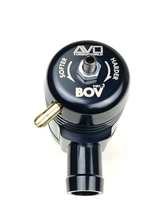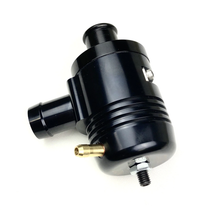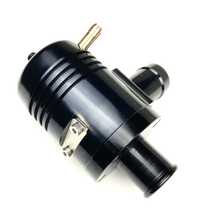AVOTurboworld Billet Blow-off Valves are essential to reliable performance for turbocharged engines. As you build air pressure in your system (boost), it can suddenly find itself with nowhere to go when you let off the throttle or in between gear shifts. Once the throttle plate closes, boost just builds up with no exit point but to go back through the turbocharger. So a blow-off valves job is to vent all that built-up pressure back into the system or out to atmosphere. This allows the turbo to continue spinning freely. This is important not just for pressurizing the air going into the engine, it is also important for the exhaust gases going out of your engine as they run through the turbo exhaust side to spin it up.
Stock BOV's are usually lightweight plastic assemblies designed to be effective only at stock boost levels. Problems can arise when you increase boost levels, possibly overloading the BOV with a higher pressure level than the standard spring was designed to handle. That's where AVO's line of BOV's for your Subaru Legacy, Forester, and Impreza come in. Our BOV's are built to take bigger boost levels, responding quickly to throttle lifts. Moreover, we've designed them so that you have a choice on how it vents. Each of our BOV's comes with a removable plate that will allow a percentage of boost to vent to atmosphere. It still recirculates the majority of the air back into the system, which is important for keeping a smooth idle. Modern ECU's on todays cars compensate for the amount of air that has been dumped back into the air flow system, and when you simply remove that air, it leads to idle problems as it throws the system off temporarily.






